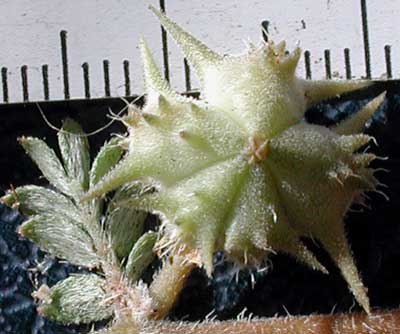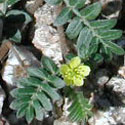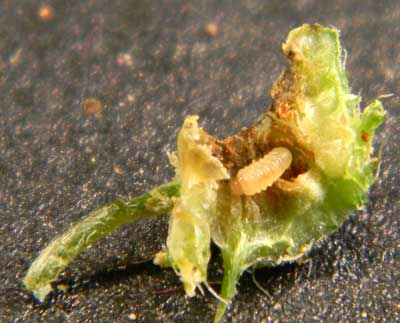Caltrop Vine
Puncture Vine
Tribulus terrestris

Image taken May 8, 2005 Phoenix, Maricopa Co., Arizona.

Close-up of the sharply thorned fruit which are sometimes referred to as Goat's Head or Caltrop. Scale is in millimeters. A shizocarp, the fruit will split into five seeds; note that two seeds will be smaller than the others.
If you ride a bicycle it is wise to learn to recognize this distinctive plant.
It grows prostrate on the ground with shiny, dark green, compound leaves and  has five-pointed, bright yellow flowers. What is often not
obvious from the height of a bicycle are the extremely sharp and sturdy seeds
with points arranged in a tetrahedron. There is a similar man-made device known
as a caltrop which was made from wood or metal and deployed in wartime as a
defense against cavalry or track vehicles. The tetrahedron shape means that a
sharp point is oriented upward at all times. Caltrop Vine seeds lie ready and
waiting to be carried away in a tire, shoe or bare foot.
has five-pointed, bright yellow flowers. What is often not
obvious from the height of a bicycle are the extremely sharp and sturdy seeds
with points arranged in a tetrahedron. There is a similar man-made device known
as a caltrop which was made from wood or metal and deployed in wartime as a
defense against cavalry or track vehicles. The tetrahedron shape means that a
sharp point is oriented upward at all times. Caltrop Vine seeds lie ready and
waiting to be carried away in a tire, shoe or bare foot.

When broken open seeds containing weevils will have a brown, hollowed-out center and the small cream-colored larva (grub)of Microlarinus lareyniei may be present.
This relative of the creosote bush, native to North Africa, was likely dispersed to the Southwest via the hooves of horses carrying early Spanish Conquistadores or missionaries. A couple of weevil species from India have been introduced as biological control agents, but my observation is that the weevils are heavily parasitized by wasps and as a result are not so effective in reducing puncture vine populations.